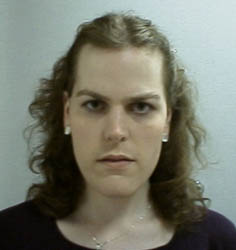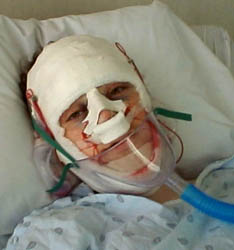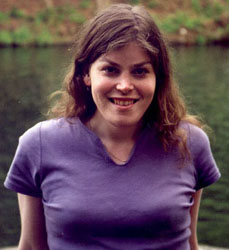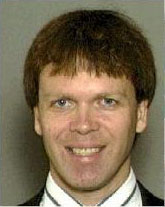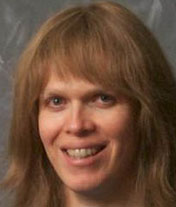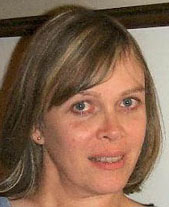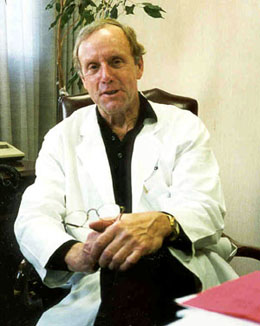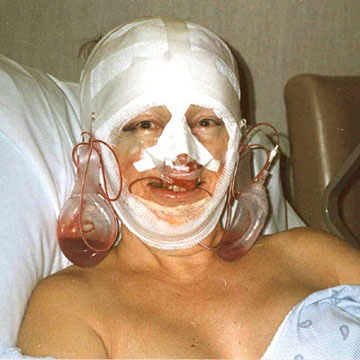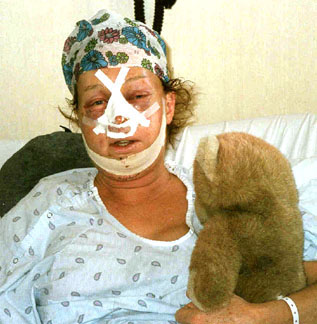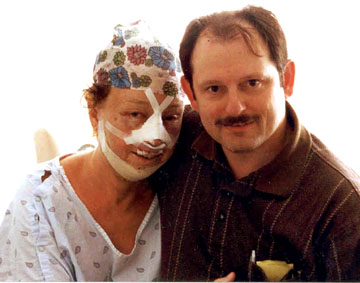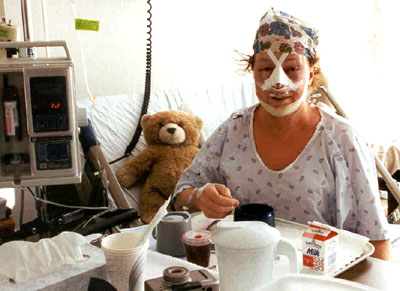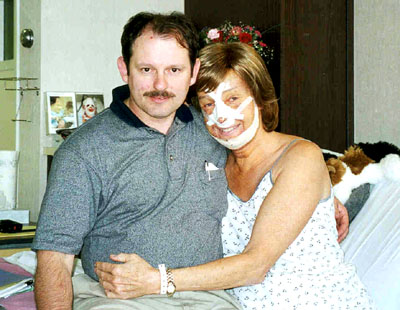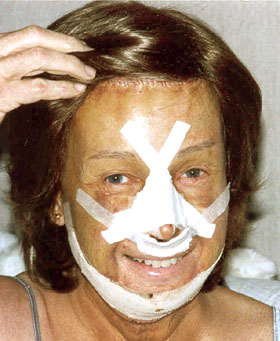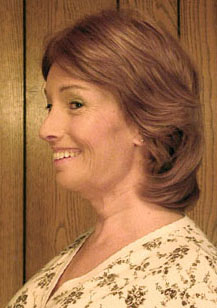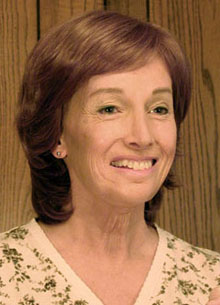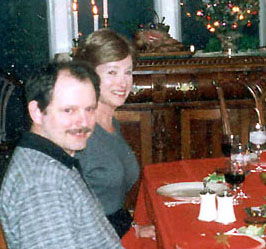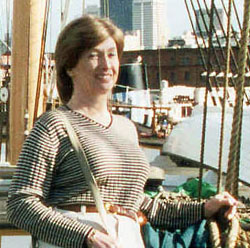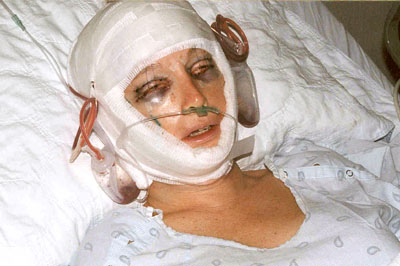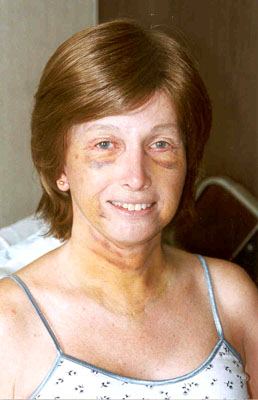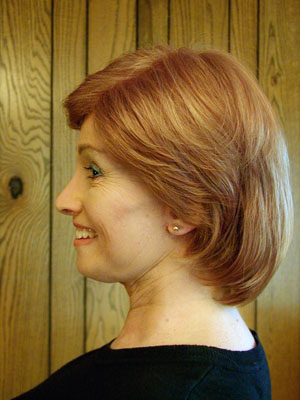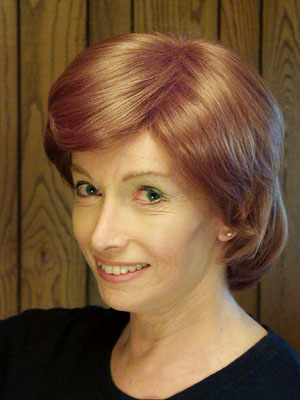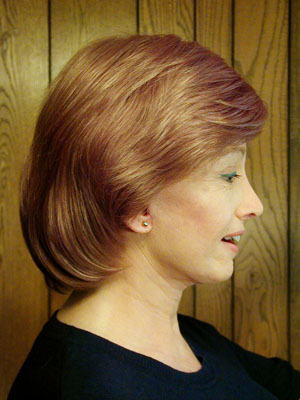(Englisch)
Ins Deutsche übersetzt von [LC update of 1-15-06] |
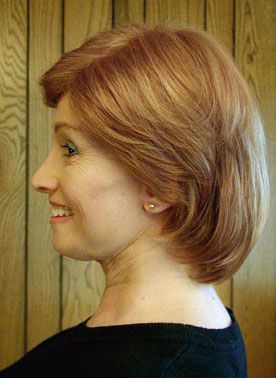 |
|
|
Ziel der Operation ist es, die in der Pubertät durch Einfluss von Testosteron bei MzF Transsexuellen entstandenen typisch männlichen Merkmale am Gesichtsschädel zu entfernen oder abzuschwächen. Auf den Webseiten von Andrea James, Becky Allison, Gina, Madeleine, Nicki, Sally und Rachel (alle waren Patienten von Dr. Ousterhout) wird mit Bildern von vor und nach der Operation sowie Erfahrungsberichten veranschaulicht, was heutzutage möglich ist. Seht euch auch Diane's page about FFS surgery with Dr. Ousterhout und die “FFS- Seite” auf “beginninglife.com” an, wenn ihr mehr Links zu Fotos und Geschichten hinsichtlich der operativen Feminisierung des Gesichtes finden wollt.
Diese Webseite enthält Hintergrundinformationen, ein Tagebuch und einige Fotos zu Lynns Operation. Sie soll Transsexuellen helfen, die eine solche Operation planen.
|
|
Viele der FFS- Techniken sind in Dr. Ousterhouts Lehrbuch “Aesthetic Contouring of the Craniofacial Skeleton von 1991 beschrieben. Die Techniken gehen weit über das hinaus, was in der traditionellen kosmetischen Chirurgie angewendet wird. Beispiele dafür sind auf Darstellungen und Fotos im Buch zu sehen. (z.B. chirurgische Entfernung und Neuformung des Knochens von Stirn und Augenhöhlen zur Entfernung des männlichen Augenbrauenwulstes).
Die operative Feminisierung des Gesichtes (FFS) wird heutzutage auch von anderen plastischen Chirurgen in vielen Ländern erfolgreich durchgeführt. Die Kosten variieren sehr stark. Es gilt auch hier, dass nicht immer der teuerste gleichzeitig der beste Chirurg ist. Vivian Silver, M.D., Ph.D.]
Auf der Grundlage von bestimmten anthropologischen Messungen konzentriert sich Dr. O. bei Transsexuellen darauf, die biometrischen Merkmale des Gesichtes dem Normbereich des weiblichen Geschlechtes anzunähern. Im Laufe der Evolution haben die Erfordernisse des Überlebenskampfes dazu geführt, dass sich der männliche Gesichtsschädel entsprechend der Aufgaben des Jagens und Kämpfens veränderte. Zum Schutz des Kopfes bildeten sich prominente Augenbrauenwülste und kräftige Unterkiefer. Im Gegensatz dazu sind weibliche Gesichter und Kindergesichter so geformt, dass ein ungehinderter Blick möglich ist, um Gefahren rechtzeitig erkennen und sich besser verstecken zu können. Die Augen sind bei ihnen etwas weiter vorne und es gibt keine Augenbrauenwülste. Die geschlechtsspezifischen Unterschiede am Schädel entstehen bei Jungen und Mädchen unter dem Einfluss der Geschlechtshormone Testosteron und Estradiol.
Die rasche Vermännlichung der Form des Gesichtes bei Jungen beginnt während der Pubertät und hält an bis ins dritte Lebensjahrzehnt. Das Testosteron verursacht auch die Bartentwicklung und die Vertiefung der Stimme. Die Entfernung der Quelle des Testosterons (der Hoden) verhindert die Vermännlichung, (siehe auch Takeshi Ishikawas Webseite mit der Beschreibung von zwei Hirjas). Als Voraussetzung für ihren Eintritt in die Hirja- Kaste lassen sich seit vielen Jahrhunderten zahlreiche Transsexuelle in Indien vor der Pubertät freiwillig kastrieren. Sie leben danach als Frauen in den “Hirja- Familien”. Die zwei Hijras auf Takeshis Foto haben keine Augenbrauenwülste, ihre Unterkiefer und die Kinns sind schmal und ihre Stirne gehen in glatten Konturen in den Nasenrücken über. In Abwesenheit des Testosterons sind ihre Gesichtsformen kindlich geblieben und ähneln sehr denen von anderen hübschen jungen Frauen, obwohl die Hirjas gewöhnlich keine weiblichen Hormone bekommen.
Was kann man aber machen, um TransFrauen zu helfen die durch die Umstände gezwungen waren, als Jungen aufzuwachsen und die Vermännlichung des Gesichtes durchzumachen? Die chirurgische Feminisierung der männlichen Gesichter kann durch Neuformung der Stirn, Verminderung oder Entfernung der Augenbrauenwülste, Korrektur des Nasenrückens, Verkleinerung des Unterkiefers und des Kinns (mit Neupositionierung des Kinns in einem neuen Winkel) sowie Abschleifen des Adamsapfels verwirklicht werden. Diese Operation ist aber, wie auch die rekonstruktive Chirurgie bei Unfallopfern und Kindern mit Kieferspalte oder anderen Deformierungen des Gesichtes, sehr aggressiv.
|
Madeleine - vor, während und nach ihrer operativen Feminisierung des Gesichtes, durchgeführt von Dr. Douglas Ousterhout. Die Veränderung ist sehr deutlich. Madeleine ist jetzt eine schöne Frau: |
||
|
|
|
|
Solch eine große Operation macht man nicht aus kosmetischen Gründen. Die Patientin muss sehr motiviert sein und bereit, das Risiko von Komplikationen sowie Schmerzen und Leiden auf sich zu nehmen. Die Zeit der Heilung nach der Operation ist schmerzhaft und traumatisch. Viele der Beschwerden halten lange an. Es kann Monate dauern, bis Schwellungen zurückgehen. Das Taubheitsgefühl am Kinn verschwindet nur langsam. Anteile der Kopfhaut können für ein Jahr oder dauerhaft taub sein.
Bei Transsexuellen mit ausgeprägten Augenbrauenwülsten und großen Unterkiefern ist diese Operation jedoch sehr bedeutsam. Für diese TransFrauen ist nur auf diesem Weg ein Leben, in dem sie von allen als Frau akzeptiert werden, möglich. Sie wären sonst wegen ihres Aussehens der andauernden Ablehnung ausgesetzt. Bei vielen wird durch die operative Feminisierung des Gesichtes verhindert, als “Transe” oder “Tunte” betrachtet und eingeschätzt zu werden. Das Gesicht erhält schöne, weibliche Züge.
Seht euch als Beispiel die drei Fotos von Sally an. Das erste Foto (links) zeigt sie als gut aussehenden Mann. Das zweite Foto zeigt sie nach zwei Jahren Hormontherapie und Bartentfernung. Viele Transsexuelle wären damit schon zufrieden und würden denken, sie sieht doch schon richtig gut aus.
Ihr werdet aber erkennen, dass sie auf dem zweiten Bild noch als “Transe” angesehen werden kann. Die Augenbrauenwülste, das hohe Kinn und der breite Unterkiefer sahen auf dem ersten Bild als Mann gut aus. Jetzt wird jedoch ihr Aussehen als Frau beeinträchtigt. Das dritte Bild wurde nach der operativen Feminisierung des Gesichtes aufgenommen. Wir sehen jetzt, warum sie auf dem zweiten Foto nicht hübsch war. Die Veränderungen sind dezent, aber grundlegend. Sie ist jetzt eine beeindruckend schöne Frau, selbst ohne Make-up. Das ist ein herausragendes Ergebnis. Nicht immer kann das erreicht werden. Die Operation kann trotzdem sehr oft durch Verbesserung der Akzeptanz als Frau in der Gesellschaft und den damit verbundenen Gewinn an Selbstbewusstsein das Leben erleichtern.
Vor der Geschlechtsanpassung; nach zwei Jahren Hormontherapie und Bartentfernung; nach FFS bei Dr. Ousterhout
|
|
|
|
Nun, was ist hier passiert? Wie konnte sich ihr Aussehen so radikal verändern? Wir finden die Antwort, wenn wir uns eine Folge von Profilaufnahmen ansehen. Wir selbst sehen uns fast nie im Profil an. Andere Leute tun das sehr oft. Es sind unsere Gesichtsstrukturen im Profil, die das Aussehen und die Geschlechtsspezifität bestimmen. Die Form des Profils verhindert oft, dass TransFrauen hübsch wirken.
Die folgenden zwei Fotos zeigen Sally vor und nach der FFS im Profil. Die Veränderung ist enorm. Ihr Aussehen im Profil war vor der FFS sehr unvorteilhaft für eine Frau, obwohl es von vorne ganz "OK" war. Nach der FFS sind die Augenbrauenwülste verschwunden, die Kontur ist abgerundet, Nase und Stirn sind neu geformt, Kinnhöhe und Kinnwinkel sind stark modifiziert und die Breite des Unterkiefers ist reduziert.
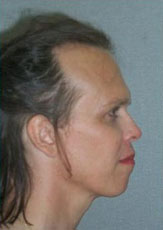 |
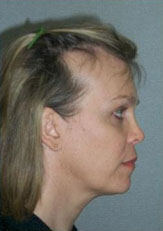 |
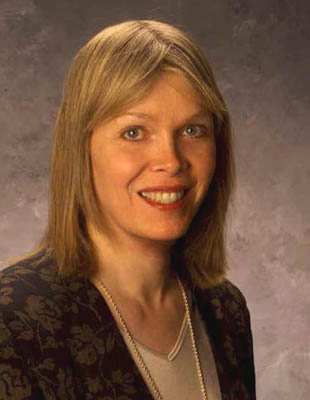 |
Die FFS hat einen genauso großen Einfluss auf das Leben von TransFrauen und ihre Chancen, glücklich zu werden, wie die operative Geschlechtsangleichung. Eine Frau, die die Vermännlichung ihres Gesichtes rückgängig machen kann gewinnt viel mehr, als es bei einer herkömmlichen Schönheitsoperation der Fall ist. Sie gewinnt durch diese aggressive Operation Selbstbewusstsein und die Genugtuung, den ihr entsprechenden Platz in der Gesellschaft zu finden. Rebecca Kastls Essay: "To Pass or Not to Pass" gibt einen Einblick in diesen Prozess. Ihr könnt auch lesen, was meine Freundin Emily Hobbie hierzu gesagt hat:
"Wenn ich vor der Operation ausging, konnte mich nichts davor schützen, von manchen als merkwürdig wahrgenommen zu werden. Es geht hier nicht darum, nicht akzeptiert zu werden, sondern darum, wie ich als Mensch von den Leuten angesehen wurde. Ich möchte, dass die Leute ganz klar *mich* sehen und zwar nicht voller Zweifel, wer ich wohl sein könnte. Obwohl ich vor Dougs Operation auch glücklich und aufrecht war, beeinträchtigten die Formen meines Gesichtes, die nicht zu mir passten, mein Selbstvertrauen und waren so falsch wie eine Haarlocke, die mit noch so viel Wachs nicht in die richtige Form gebracht werden kann.
Ich bin sicher, dass ich, auch wenn Dougs Operationstechnik nicht existieren würde, das Beste daraus gemacht hätte. Ich vermute aber, dass der Unterschied zwischen wer ich bin und was mein Gesicht ausdrückt mich aufgefressen hätte, so glücklich ich auch gewesen wäre. Wer weiß.
Ich kann jetzt nicht nur ganz einfach durch die Welt gehen (das Beste was ich mir vor der Operation gewünscht hatte), sondern das Leben aktiv gestalten und inneren Frieden finden. Andere können es sehen und wahrnehmen. Es ist eine wunderschöne Wechselbeziehung, in der mein Wohlbefinden zu anderen ausstrahlt, die meine innere Ruhe spüren und mein Glück reflektieren - - - . "
Die Anzahl der FFS- Operationen von Dr. Ousterhout ist Mitte bis Ende der 90ger Jahre, als diese Therapie unter Transsexuellen und ihren Therapeuten bekannt wurde, sehr schnell angestiegen. Die Bekanntheit wurde noch größer, als Webseiten mit Bildern von “vorher und nachher” sowie Informationen darüber im Internet erschienen. Andrea James hat als erste solche Bilder im Internet gezeigt. Danach kamen Nicki, Sally, Lynn und viele andere. Im Mai 2001 hatte Dr. Ousterhout bereits etwa 525 bis 550 Transfrauen operiert.
Viele MzF Transsexuelle lassen die FFS jetzt vor ihrem Alltagstest durchführen. Das erleichtert ihre Akzeptanz als Frauen sehr, weil sie wesentlich weiblicher aussehen. Andrea, Gina, Madeleine, Nicki, Sally und Rachel waren alle in der frühen Phase der Geschlechtsangleichung als sie bei Doug ihre FFS hatten.
Die bessere Akzeptanz als Frauen erleichtert es den Transsexuellen weiter berufstätig zu sein und ihr Einkommen zu sichern, während sie sich in der Zeit der Alltagserfahrung auf ihre genitale Operation vorbereiten. Die FFS ist zwar teuer, kann aber den Einkommens- und Jobverlust verhindern und damit die Kosten mehr als kompensieren. Die Erfahrung zeigt, dass die FFS- Kosten steuerlich absetzbar sind, weil die FFS Teil der Geschlechtsangleichung ist und keine kosmetische Operation.
Dr. Ousterhouts Büro befindet sich im Davies Campus des California-Pacific Medical Center. Seine Adresse ist: Douglas Ousterhout, M.D., D.D.S., 45 Castro Street, Suite 150, San Francisco, CA 94114; Telefon: (415) 626-2888; e-mail link.
Bei Interesse an einem Termin ist Dr. Ousterhouts Assistentin Mira Coluccio telefonisch erreichbar. Mehr Informationen zu Dr. Ousterhout und seiner OP- Methode gibt es über folgenden Link: http://www.drdouglasousterhout.com/
[Anmerkung der Übersetzerin:
Adressen von anderen Chirurgen, die die FFS durchführen,
findet ihr, wenn ihr z.B. bei
www.google.com das Stichwort Facial Feminization Surgery eingebt.
Vivian Silver, M.D., Ph.D.]
Warum Lynn die FFS durchführen ließ:
Lynn ist eine über 55 Jahre alte TransFrau, die bereits 1968 ihre geschlechtsangleichende Operation hatte. Sie hatte Glück und wurde immer als Frau anerkannt. Sie hat Karriere gemacht und hatte ein wunderschönes Leben als Frau.
Lynn war sich aber immer der entsetzlichen Vermännlichung im Gesicht bewusst, die am Ende der Pubertät entstanden war, obwohl diese bei ihr nicht so stark ausgeprägt war wie bei anderen Transsexuellen. Mit Hilfe der modernen FFS konnte sie die Zeit zurückdrehen und die meisten der männlichen Merkmale am Gesicht beseitigen lassen. Für Lynn ging es darum, ihr Leben zu bereichern und das psychische Wohlbefinden und die Lebensfreude zu steigern.
Lynns FFS schloss folgende Maßnahmen ein: Vorverlagerung der Haarlinie, Stirnformung, Augenbrauenwulstentfernung, Augenbrauen- Neupositionierung, Nasenplastik, Unterkiefer- und Kinn- Neuformung sowie das Abschleifen des Adamsapfels. Die Ergebnisse sind dezent, aber beeindruckend. Lynn sieht immer noch aus wie Lynn, besonders von vorne betrachtet. Das Profil hat sich jedoch stark verändert. Wenn Lynn eine Schwester hätte, würde sie ihr jetzt sicher ähneln.
Lynn hofft, dass die Informationen und Erfahrungen, die auf dieser Seite zu finden sind denen helfen werden, die eine FFS planen. Für weitergehende Fragen könnt ihr mit Lynn per E-Mail (Adresse auf der Homepage) Kontakt aufnehmen. Lynn bemüht sich, diese Seite auf dem neuesten Stand zu halten. Wenn ihr Anmerkungen zu dieser Seite habt, schreibt es Lynn.
Mehr Informationen über Lynn mit vielen früheren Fotos sind auf ihrer Homepage: http://www.lynnconway.com.
Diese Seite enthält Medienbeiträge über ihr Leben:
http://ai.eecs.umich.edu/people/conway/Media/Media.html.
Hier ist ihr persönlicher Rückblick:
http://ai.eecs.umich.edu/people/conway/RetrospectiveT.html.
Entscheidung und Vorbereitungen:
Ich bin immer gerne draußen in der Natur gewesen, habe oft den Rucksack geschnürt, bin geklettert, gerannt, bin Kanu gefahren, war auf Motorkrossrennen usw. All diese Jahre sind durch die Sonne und das natürliche Altern einige Falten an Gesicht und Hals entstanden. Anfang 1999 fing ich an, Informationen über Face-Lifts und andere kosmetische Methoden zur Verjüngung zu sammeln.
Ich war auch im Internet auf Seiten von anderen Transsexuellen und informierte mich über Gesichtschirurgie. Dabei fand ich die erstaunlichen Fotos auf Andrea James Webseite. Nachdem ich die “Vorher- und Nachher- Bilder” von Andrea und anderen Patientinnen besonders im Profil gesehen hatte, begann ich zu verstehen, wie sehr die Formen von Augenbrauenregion, Unterkiefer und Kinn das geschlechtsspezifische Aussehen, gerade bei MzF- Transsexuellen bestimmen. Deshalb wollte ich wissen, wie weit das Konzept der FFS von Dr. Ousterhout fortgeschritten war.
Während einer Reise nach Kalifornien im Juni 99 verabredete ich mich mit Dr. Ousterhout, um herauszufinden, was er für mich tun könnte. Entsprechend Miras Anweisungen hatte ich Röntgenaufnahmen des Schädels, die ich in der Innenstadt von San Francisco hatte machen lassen, bei mir. Doug untersuchte mich und musterte die Röntgenbilder, dann diskutierten wir alle Möglichkeiten. Er erklärte mir, dass Stirn, Augenbrauenregion, Nasenrücken und auch Unterkiefer sowie Kinn neu geformt werden könnten. Als mir bewusst wurde, welch eine Verbesserung möglich war, fing ich an, die Operation ernsthaft in Betracht zu ziehen. Wieder zu Hause nahm ich per E-Mail Kontakt mit einigen früheren Patienten von Dr. O auf, um mehr über deren Erfahrungen und die OP- Ergebnisse zu erfahren.
Mitte Juli entschied ich mich, die Operation durchführen zu lassen. Ich wollte sowieso ein Face-Lift machen lassen und jetzt wusste ich, dass es ein Fehler gewesen wäre, nicht vorher die Gesichtsknochen umformen zu lassen, denn nach dem Face-Lift hätte die FFS die Ergebnisse des Liftens zunichte gemacht.
Ich hatte zwar im Laufe der Jahre schon einige Operationen (einschließlich der operativen Geschlechtsangleichung) über mich ergehen lassen, aber nach den Beschreibungen der anderen Patienten war klar, dass die FFS im Vergleich dazu wohl eine Tortur sein muss. Ich wusste aber auch, dass, wenn man mental auf Schmerz und Verletzung vorbereitet ist und dadurch nicht psychisch beeinträchtigt wird, nach der Operation die schlimmen Erinnerungen sehr bald verschwinden werden. Im Falle der FFS ist außerdem der Nutzen weitaus höher einzuschätzen als das hinzunehmende Leid und die Kosten.
Im August 99 hatte ich einen weiteren Termin bei Dr. O. Wir entschieden uns für die gesamte Prozedur, eine vollständige FFS mit allen dazugehörigen Maßnahmen während einer langen Operation. Er legte den OP- Zeitpunkt für den 10. November fest und ich zahlte eine Anzahlung. Bald war es also so weit.
Zwischen August und Oktober hatte ich die Chance, Sally und Nicki, zwei Frauen, die die gesamte FFS hinter sich hatten, persönlich kennen zu lernen. Ich war erstaunt über die erzielte Veränderung und lernte eine Menge über die OP und den Zeitraum der Heilung danach. Das schloss eine Reihe von praktischen Tipps ein.
Ich fing an, mir Sorgen zu machen. Zum Beispiel dachte ich, ich könnte klaustrophobisch werden, wenn ich fünf Tage lang einen dicken Verband an der Nase einschließlich Tamponaden tragen muss. Deshalb machte ich eine Art Test. Ich aß und schlief mit einem aufgesetzten Nasenklipp. Das war nicht ganz einfach, ich konnte kaum schlucken und meine Ohren pochten die ganze Zeit. Aber ich gewöhnte mich daran. Schließlich dachte ich, dass der Nasenverband mich wohl nicht umhauen würde.
Als ich dann am Packen war und die ganze Logistik für Reise und Genesung plante, war ich immer noch oft im Internet auf Seiten von anderen Patienten. Immer noch hatte ich nicht alle Antworten auf meine Fragen. Es hat sicher auch Fragen gegeben, die ich gar nicht gestellt hatte, weil ich nicht darauf gekommen bin. Ich nahm mir vor, ein Tagebuch zu schreiben und es später anderen zur Verfügung zu stellen.
[Die Fotos weiter unten sollen zukünftigen Patienten zeigen, wie sie kurz nach der Operation aussehen könnten. Hoffentlich kann damit der Schock verringert werden, den man hat, wenn man das erste Mal in den Spiegel sieht.]
[Anmerkung der Übersetzerin:
Leider lässt es meine Zeit nicht zu, den gesamten Text von Lynns FFS- Seite
zu übersetzen. Ich denke jedoch, dass alle wesentlichen Informationen in der
deutschen Fassung enthalten sind.
Die individuellen Erfahrungen sind sehr verschieden. Ich habe z.B. die geschlechtsangleichende Operation als wesentlich belastender empfunden als die FFS. Die FFS wird von verschiedenen Chirurgen unterschiedlich durchgeführt. In manchen Fällen genügt z.B. die Neuformung des Kinns durch Aufsetzen eines Implantats ohne Veränderung des übrigen Unterkiefers. Man sollte sich vor der OP im Klaren sein, welche Veränderungen am Gesicht man haben will. Es muss nicht immer das gesamte Programm sein. Vivian Silver, M.D., Ph.D.]
